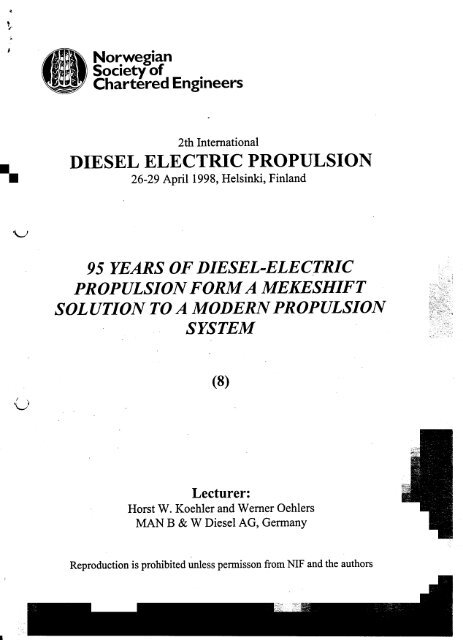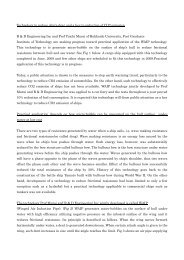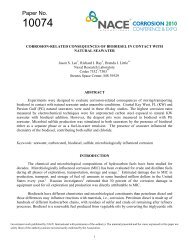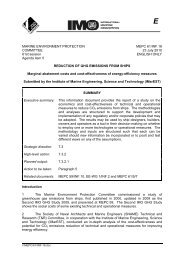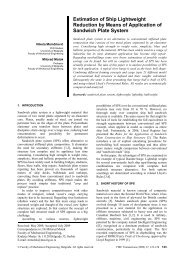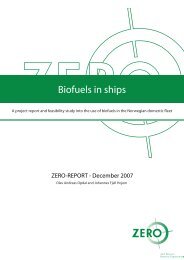DIESEL ELECTRIC PROPULSION - Clean Shipping Technology
DIESEL ELECTRIC PROPULSION - Clean Shipping Technology
DIESEL ELECTRIC PROPULSION - Clean Shipping Technology
Create successful ePaper yourself
Turn your PDF publications into a flip-book with our unique Google optimized e-Paper software.
.t ..--~I.NorwegianSocieq ofCharte red Engi neers2th International<strong>DIESEL</strong> <strong>ELECTRIC</strong> <strong>PROPULSION</strong>.. 26-29 April 1998, Helsinki, Finland'\ ,t95 YEARS OF<strong>DIESEL</strong>-<strong>ELECTRIC</strong><strong>PROPULSION</strong>FORMA MEKESHIFTSOLUTION TO A MODERN PRO PULSIONSYSTEMIV(8)Lecturer:Horst W. Koehler and Werner OehlersMAN B & W Diesel AG, GennanyReproduction is prohibited unless pennisson from NIF and the authors
.,'"[!. .t (95 YEARS OF <strong>DIESEL</strong>-<strong>ELECTRIC</strong> <strong>PROPULSION</strong>:FROM A MAKESHIFT SOLUTIONTO A MODERN <strong>PROPULSION</strong> SYSTEMHorst W. Koehler* and Werner Oehlers**, MAN B&W Diesel AG, Germany*) Senior Manager Technical Promotion; **) Senior Sales Manager Marine EnginesABSTRACT\ 1 Diesel-electric propulsion is not a new invention. When the early diesel engineswere reliable enough to be used as ship propulsion, in 1903/04, they were still nonreversible.At this time electric power transmission therefore was the only method toovercome this basic technical problem. The first marine diesel-electric applicationworldwide was the Russian river tanker" Vandar commissioned in spring 1903. Diesel-electricpropulsion was improved in the following decades. Today, modern powerelectronics have made it possible to fully utilise the "power station" concept and tomake power generation onboard even more efficient.INTRODUCTIONThis year we look back on 95 years of use of the diesel engine as a marine propulsionunit. The history started with the development of this unique engine in the yearsbetween 1893 and 1897 at Maschinenfabrik Augsburg (a forerunner of today's MANAktiengesellschaft) by its genious inventar Rudolf Diesel, with the financial support""'-'" of Fried. Krupp, Essen. In February 1897, the first "marketableJ' diesel engine (Fig.( 1) successfully went through an official acceptance test run in Augsburg, supervisedby today's Technical University of Munich. This single-cylinder, tour-strakecrosshead engine (bore 250 mm, strake 400 mm) weighed almost 4.5 tons and hadan output of 17.8 HP/154 rpm at full load. At this rating it readily demonstrated anoverall engine efficiency of 26.2 %. This was much better than the efficiency of hotbulboil engines, and no less than twice as much as that of the best steam enginesavailable at the time. With this highly impressive result, Rudolf Diesel's earlier predictionthat it would be the most economic heat engine in the world was convincinglyconfirmed - and his prophesy fulfilled.(In the decades since then the diesel engine has successfully defended this title -right up to the present day. As Fig. 2 shows, maximum overall engine efficiencies ofup to 52 % tor today's large-bore slow-speed diesel engines and up to approx. 47 %tor medium-speed diesel engines are reached, and the diesel engine continues to bethe most efficient, independent primer mover in its typical output range, currently upto 69 MW per unit.deprop.nl. ;:::=--- ~ ,;;,. 1i!i
.- 2 -..It is proof of Rudolf Diesel's vision and inventiveness that he foresaw marine applicationslang before he had even made the very first sketches for his historical dieselengine itself. MAN Archives include a three page handwritten list by Rudolf Dieseland dated May 1887 is filed, titled "Applications for small engines". In it, "smallboats" are mentioned under "different trades". At this time, however, the diesel enginehad not yet even been born, and Rudolf Diesel was still experimenting with asmall steam engine operating on ammonia.When ten years later the diesel engine was launched, adelegation from GebrüderHowaldt from Kiel, Germany, visited Augsburg to discuss with Diesel and the engineteam at Maschinenfabrik Augsburg the possible application of this new engine asmarine propulsion. Special tests with the 25/40 engine were performed during thisvisit. As a result, Rudolf Diesel proudly stated that the engine safely operated "evendown to an engine speed of 40 rpm with a brake load of only 10 kg" [1]. Historically,it is of interest to note that it was this company which was the first to build the firstdiesel-propelled vessel in Germany (the cargo ship "Monte Penedo") - but not until1912, 15 years after their very first approach to a diesel engine manufacturer. 'JiIIn February of the same year the world's first genuinely ocean-going diesel-poweredship. the "Selandia", set sail on her maiden voyage to East India. Her two direct reversiblemedium-speed diesel engines (built by Burmeister & Wain) were rated at1050 HP/140 rpm each.DRAWBACKS CF THE EARL Y MARINE <strong>DIESEL</strong> ENGINESIn the first few years after 1897, all diesel engines produced either by MaschinenfabrikAugsburg or one of the many other worldwide licensees were used entirely forstationary applications. The initial high specific weight and the large volume andheight of the first production units did not allow their use as ship propulsion. The firstdiesel engine ever sold, which went into operation exactly 100 years aga, was a twocylinder30/46 engine delivering up to 70 HP at 160 rpm. Its weight was 15.5 tonsnet, resulting in a weight-to-power ratio of 221 kg per HP. Today's state-of-the-artmedium-speed engines reach values as low as 7 to 8 kg/HP.':JThe second major drawback of the first diesel engines was that they were all non-" reversible. In spite of this, the diesel's potential for marine application - low fuel oil, consumption rates, relatively simple maintenance, compact installation, good startingI. capabilities at low ambient temperatures - forced designers and engineers to do theirf: utmost to lessen the impact of these initial technical obstacles.rC'Hence the diesel engine was always in the mind of ship designers and builders atthis time, although they still had objections to using it. It was the French engineer, and owner of a small workshop, Frederic Dyckhoff, an old friend of Rudolf Diesel andione of the earliest original diesel engine licensees (April 1893), who patented a revergingmethod for diesel engines in 1899, and one year later tested a three-cylinder15 HP/600 rpm marine diesel engine with a bore and strake of each 132 mm. Thisengine hag to be regarded as the first diesel to feature a direct reversing mechanism,based on two camshafts. They were selectively engaged for either forward or
..!- 3 -.( reverse by moving them around their common drive shaft. However, this enginecaused tao many technical problems and never left the company.In 1902, MAN (as successor of Maschinenfabrik Augsburg) began to develop marinediesel engines and a year later the decision was made to start the design of a suitablereversing mechanism. The basic idea at MAN at this time was to reverse speedby use of a reversing gear in the transmission shaft which connected the crankshaftand the camshaft. 8ut this solution also failed to bring the expected breakthrough:the first Augsburg-built marine diesel engine was still non-reversible. It was a four--- cylinder 28/30 engine with an output of 140 HP/400 rpm, but it did reach a respectablespecific weight of only 68 kg/HP and a very favourable specific fuel oil consumptionrate of only 190 g/HPh - quite a technical leap forward. Although the GermanNavy, after many negotiations and a lang correspondence, ordered this enginein June 1903, no further records exist either of this early marine engine or its application.1-.-,;<strong>ELECTRIC</strong> POWER TRANSMISSION - AN IMPORTANT STEP FORWARDThese few examples show how complicated and hence cumbersome the early attemptsto reverse the speed of diesel engines were. Unexpected help came tram acompletely different source. It was the Italian electrical engineer Cesido Dei Propastawho invented and developed a new drive tor ship screws, simultaneously tosimilar work done at Ludwig Nobel in 8t. Petersburg, Russia. Dei Proposto had hisidea patented in many countries, among others also in Germany [2]. Fig. 3 is the firstpage of the German patent No. 147927 valid tram 4th April 1903 on, and Fig. 4shows Dei Proposto's only drawing in this short (three-page) patent.Apart tram the propeller shaft (E) and the prime mover (A), his system consisted ofan engine-driven DC generator (8) and a DC motor (C). The generator producedelectrical energy which was transferred to the motor via cabling. The motors had an\., ' electrical output slightly lower as the electrical output of the generator. The motor( was continuously connected to the shaft by a coupling (M3), and a similar coupling(M1) connected the generator to the prime mover. A magnetic clutch (M2) was 10-cated between generator and electric motor. This clutch was actuated by the currentdelivered by the generator.~ generatorDuring engine standstill, the electro-magnetic clutch (M2) was disengaged in orderto facilitate startup of the engine without load. Once the engine was running, thedelivered the current to engage the clutch (M2). 8ince this was a directmechanical power transmission, the shaft (E) rotated at the same speed as the engine(A) itself. 80th the generator (8) and the motor (C) acted as flymasses tor themain engine.(During maneuvering and in case of speed reversal, the magnetic clutch (M2) wasdisengaged and the screw was propelled by the electric motor (C) only, which receivedthe current tram the generator (8). Via control of the speed of the electricalmotor, the speed of the propeller shaft (E) could be adjusted or reversed as needed.
.;~"'~~ ,~ ~"".c-'" "". .,;,- 4 - ;The second drawing in Fig. 4 shows the situation for two propulsion engines (A) and(A 1). In the normal propulsion mode, the three electromagnetic clutches (M1, M2and M3) were engaged and the propulsion of the shaft (E) was a direct one. In orderto perform maneuvers, clutch M3 was disengaged and the shaft was turned by thecurrent of the electric motors (B) and (C) similar to the description above..Dei Proposto did not specifically restrict his patent to diesel-engine applications. Instead,in his patent description he mentioned "machines or engines like explosiontypeengines, interna I combustion engines, gas and petrol engines as weil as lighting-oiland naphtha engines" [2].At first glance, with this invention the major obstacle to the use of non-reversible dieselmarine engines had almost been overcome and the attractiveness of such applicationsincreased considerably, especially since the power-to-weight ratio was improvedfrom year to year, and hence the reliability of the early diesel engines.THE WORLD'S FIRST <strong>DIESEL</strong>-PROPELLED VESSELS,JFig. 5 lists the world's first vessels to be propelled by diesel engines. Clearly, theiroutput was limited. In this paper, however, we shall primarily focus Dur attention ontheir propulsion systems. .The difticulty at the beginning of this century remained how to make the vessels asmaneuverable as possible. While waiting for the ideal solution to this challengingtask, a number cf operators, as Fig. 5 shows, opted for electrical power transmissionas a makeshift solution.The first diesel-engine driven ship was"the Russian 75 m, 800 tdw, triple-screw rivertanker" Vandaf', operated by the St. Petersburg-based Nobel Petroleum Companyon the Volga River and the Caspian Sea (Fig. 6). The maiden voyage was in spring1903, shortly after the ice hag broken up after the winter. Three trunk-piston, three- ~cylinder diesel engines had already been delivered in autumn 1902 by the Swedish V: manufacturer A.B.' Diesels Motorer, becauseNobel's own diesel engine department \~ (Ludwig Nobel Machine Co.) could not otter diesel engines with the required output.l The engines were each rated at 120 HP/250 rpm allowing a cruising speed of up to 8rknots; they were not reversible.fContrary. to publications in the literature, the "Vandaf' was not propelled by aDel~ Pro~ost? system ~ut a diesel-electric propulsion system. This was the very first OEr appllcatlon worldwlde.,r, The three propellers of the vessel were driven by three midship-mounted propulsionunits. Each of these units consisted of a three-cylinder diesel engine and a DC generatorof 87 kW at 500 V. These generators were wired to three motors with an electricalpower requirement each of 75 kW, turning the propeller shafts. Control of eachgenerator/motor group was facilitated by the alternators exciter current, and it waspossible to control each screw independently from the two others from the bridge.The electrical gear for this first all-electric diesel application was designed and builtby ASEA, Sweden, as far as known by adapting controls from those used in electricstreet cars.
..t- 5 -, The armatures of the generators and the electical motors were directly and continu-( ously connected. This control system had the advantage of maneuvering capabilitieswith low current intensities (exciter current). A second benefit was the start-up capabilityof the system at full amperage without need of strang resistors.Except a serious engine failure during the maiden voyage, delaying commissioning,the operating experience of this first all-electric drive onboard the "Vandaf' was reportedlyexcellent: the reversing procedure from full ahead to full reverse took only 8to 10 seconds. In spite of that, not everybody was happy. Dei Proposto commentedthe high losses of the overall system: from the total engine output of 360 HP, only290 HP were effective at the screws, which is apower lass of almost 20 %.Of course the DE propulsion system onboard the "Vandaf' was rather heavy. Thethree diesel engines were the lightest of their time and had a weight of 48 tons, with31.2 tons added for the electrical components. This means 40 % of the overallweight of the whole propulsion system was the electrical machinery.~In his later bock "Der Antrieb von Schiffen durch nichtreversierbarepublished in 1906, Fig. 7, Dei Proposto wrote:Maschinen","... It is quite obvious that the continuous electrical transmission has major advantages,but also considerable disadvantages. Considering the pros and Gons, it seemsthat the problem of propelling large vessels by non-reversible engines is not yetsolved, or at least not solved satisfactorily enough.. ."[3J.The river tanker" Vandaf' operated until 1913, mostly carrying lamp oil, and wasscrapped shortly thereafter.The second diesel-engined ship was the flat-bottomed, shallow French canal barge"Petit Pierre" (Fig. 8), equipped with a 25 HP/360 rpm diesel engine developed jointlyby Dyckhoffs Societe Franc;aise des Moteurs R. Diesel at Bar-le-Duc and its Parisbasedsub-licensee Sautter, Harle & Cie. The midship-placed small single-cylinderV engine was a horizontally opposed piston engine, without possibility to reverse rota-( tion directly. Most likely this engine was derived from an existing horizontallyopposedSautter-Harle gasoline engine which was modified to run on the diesel cycle.Maneuverability of the new diesel engine was achieved by adjustable propellerblades.The vessel began operation on the Marne-Rhine river in September 1903, half ayear later as "Vandaf' in Russia. SinGe this canal passed through the city of Bar-le-Duc, it was easy for Dyckhoff to monitor performance and reliabilty and to do repairjobs.In late October 1903 Rudolf Diesel accepted an invitation from Frederic Dyckhoff totake a day trip on the "Petit Pierre".No record exists of the experience and the service life of the engine.The third ship with diesel propulsion was the "Ssarmaf'(Fig. 9). She was the sistervessel of the "Vandal" with identical size but different engines types and engine arrangement.She was equipped with two four-cylinder 32/42 engines of the same total( output as the three installed onboard the "Vandaf'. This time the engines were suppliedby Ludwig Nobel. The two engines (each rated at 180 HP/260 rpm), contrary to
.- 6 -.the engine room of the " Vandal" , were placed near the stern and turned the propellersvia a semi-electric drive according to the Dei Proposto system.This system turned out to be somewhat more efficient than the " Va nda/'s " all-electricone. The reverse mechanism consisted of an engine-driven generator, a magneticclutch and a motor, all coaxial with the shaft. When going ahead, the magnetic clutchwas energized to couple the engine directly to the propeller, avoiding the high electricallosses of the all-electrical transmission of the "Vandar. In astern, the clutchwas disengaged, and the generator drove the motor in the opposite direction. Sincemaneuvering always is limited timewise, the alternators and electrical motors couldbe designed for a much lower electrical output as necessary for the continuouselectrical power transfer onboard the "Vandar.This had its effect on the weight of the propulsion unit of the "Ssarmaf': the totalweight of the two engines plus the electrical machinery was 65 tons as compared to81 tons for the "Vandar, and the ship's speed was 8.6 knots maximum (" Vandar: --max. 8.0 knots). )The vessel made her maiden voyage in the summer of 1904. She reached a muchIonger service life than her si ster vessel: she was still in operation in 1923, but nofurther information is available from that time on.It should be noted that both the "Vandar and the "Ssarmaf' were only in operationduring the summer seasons, since the rivers were frozen up during the lang Russianwinters.The fourth vessel with a diesel engine was the French submarine "Aigrette" , whichentered into service in 1904. This makes the French Navy the first institution to introducediesel-powered submarines, and their diese! fleet was actually the world'slargest for over a decade. "Aigrette" was powered by a four-cylinder, four-strokeSautter-Harle engine rated at 200 HP, basically an upgraded version of the proven"Petit Pierre" engine. Not very much is known about the service experience with the , ,engine of this submarine. It was also a non-reversible one, most likely using the Velectric generator and motor drive for surface maneuvering.This submarine had a surface displacement of 178 metric tons. A second Frenchsubmarine, "Cigogne", with the same engine and a displacement of 250 metric tons,followed the same year.~ "Venoge"The final ship in the list of early diesel-propelled vessels is the Swiss cargo boat(Fig. 10) on Lake Geneva (Switzerland), which went into service at thebeginning of December 1905. The engine was a two-cylinder, 40 HP/260 rpm fourstrakeengine. This engine was again of the same type as those used in stationaryapplications and consequently could only run in the ahead direction, hence why itwas equipped with aDel Proposto electro-mechanical reverse system.According to Dur information, the "Venoge" is still in use today on Lake Geneva as apile-driving vessel, however equipped with modern high-speed diesel engines. Heroriginal first engine (with the Dei Proposto system) was removed in 1924 and soldfor electricity generation in France, where it still ran for several years.
-i- 7 -I( The above examples show that the electrical transmission of diesel-driven shipsdates back to 1903. It is clear that the motivation for use of such systems was thefact that diesel engines in those days were only available as non-reversible units.With the availability of the direct reversible two- and four-stroke diesel enginescommencing the year of 1906, the OE drive temporarily lost attractiveness.However, in the 20s, electrical power transmission set records again and becamevery popular, in particular on ice breakers (due to the demanding torque requirements)and on research vessels (the first icebreaker with OE propulsion was theFinnish built "Sisu"). As early as the 1930s, a number of OE systems on passengerships consisted of a OC generator and a OC electric motor. The speed of the drivingmotor could be altered by switching a relatively low inducing current in the generator.This technique was improved more and more over the years and continued to beused until the 1970s [5].'-' One outstanding and most sophisticated application of that period was the 16,500 -ton Hapag liner "Patria" with 15,000 HP twin-screw machinery, the largest ship of hertime to be propelled using the OE system [6]. She was on regular service to the westcoast of South America via Southampton, the Panama Canal and Valparaiso. Thevessel carried 185 passengers in first class, 164 in second or tourist class, and acrew of 241.The heart of the machine room comprised six MAN GZ 52/70-type two-stroke, singleacting,trunk-piston engines. They engined three-phase alternators of 2,140 KVA,running at 250 rpm, which in turn supplied current to two 7,500 HP or 5,500 KVAsynchronous motors. Those were coupledto propellers, which turned at about 110rpm for the maximum ship's speed. Five alternators were driven ,by five eight-cylinderengines, whilst the sixth of 1,605 KVA was driven by a six-cylinder version.The six generating sets were arranged in two groups of three in two separate machinerycompartments, divided by a watertight bulkhead.~ ADVANCES IN <strong>DIESEL</strong>-<strong>ELECTRIC</strong> <strong>PROPULSION</strong>The breakthrough for the diesel-electric propulsion on cruise ships was in the mid1980s thanks to the development and availability of sophisticated power electronics.f '" Contrary to stationary power plants, it is not only the load which is changing on-" board ships due to the varying ship speed, but also the frequency due to the varying-. propeller speed.,Power electronics have made it possible to install frequency converters and utilisethe "power station" concept, making the onboard power generation more efficient.The "Queen Elizabeth 2" was the first modern passenger and cruise vessel for whichthe power station concept was utilised for its 95.5 MW propulsion plant consisting ofnine MAN B&W 9L 58/64-type medium-speed engines. It was also the "QE2" onwhich directly resiliently mounted medium-speed engines are used the first time tofulfil the stringent noise and vibration requirements.I..
~-'.) ~.~- 8 - -The "QE2" is a trend-setter for today's and future cruise vessels for both the electricpower station concept and for low noise and vibration installation onboard of cruisevessels. More details will be presented in a later paper during this conference.OPTIMAL ENGINE SELECTIONThe new generation of AC/AC electrical drives has been brought about by the developmentof reliable high-power semi-conductor devices and their control systems.The development of solid-state semi-conductor devices such as thyristors, transistorsand integrated circuits has given the old technology new relevance, now beingused in cyclo-converter or synchro-converter systems, just to name the two mostpopular systems in use.The power control devices called "thyristors" are available in various configurations.As can be seen from various papers on diesel-electric propulsion systems presented ...,...)in the past, mainly by electrical equipment suppliers, most of them are dealing withelectrical aspects only, ignoring the impact of different diesel engine types.Diesel-electric transmission doubtlessly provides a number of well-known advantages,i.e. flexibility of operation, distribution of propulsion and hotel load, power stationconcept, flexibility in the arrangement of the main components such as gensets,converters, switchgears and propulsion motors.Cf course it is a well-known fact that the electrical transmission has the disadvantageof higher equipment and investment costs and higher propulsion losses thanthe mechanical transmission.To justify the decision in favour of the electric transmission system, these disadvantagesmust be compensated by advantages of the diesel-electric transmission, suchas matching the load profile by the optimal number of gensets in operation andachieving a higher number of cabins due to the space-saving engine arrangement.When talking about the first argument, i.e. optimal number of gensets in operation,the mission profile and load profile of the vessel is of eminent importance.In fact, the mission profile of avessei and thus the load profile of the prime moversin operation will decide whether or not electrical transmission can be justified.The electrical equipment and system suppliers try to promote smaller high-speedgenerators to reduce the equipment cast, i.e. the cast for the generators. Higherspeedgenerators, however, require high-speed diesel engines. Depending on thepower level, this offen results in the selection of Vee-type engines.Compared with large-bore in-line engines, this means higher numbers of cylindersand consequently much higher cylinder running hours for a given load and highermaintenance costs, spare part costs as weil as higher fuel consumption rates due tothe difference in specific fuel consumption between higher-speed Vee-type enginescompared to large-bore, lower-speed in-line engines.Vil':;"
.?,,'~ 7.~,.;.,- 9 -( A similar comparison can and should of course be made tor any power level requiredtor a cruise vessel design.Dur investigations lead to the conclusion that tor any given power level prime moversshould be selected according to the lowest possible specific fuel oil consumptionand the lowest number of cylinders.fRegarding the engine room arrangement onboard a ship, electrical power transmissionprovides the freedom of placing the "diesel power station" at a location whichsuits best the requirements of the owner and/or naval architect.- Depending on the size and type of the machines selected, there is a choice betweenthe traditional "horizontal" engine room and a "vertical" engine room arrangement.~ - Weight and space required of the "power station" will mainly dictate the choicebetween "horizontal" or "vertical" engine room arrangement.- The space saving aspect is one of the reasons to place the electric propulsionmotor outside the ship's hull, which is known as the "Azimuthing Podded Drives",being meanwhile weil accepted by shipowners and shipyards.EMISSIONSShips with diesel-electric propulsion are in a better position to reach the attribute of"green ships". For instance, as the engines run at constant speed, they can be adjustedin such a manner that the exhaust gas contains only a minimum percentage ofharmful pollutants, in particular if the shipowner decides to use low-sulphur marinediesel oil rather than heavy-fuel oil available as "waste" residues tram the processingand refining of crude oil. Furthermore, at lower loads, the constant-speed engine~ produces less NOx and CO2 than a diesel engine operating at variable speed.The noxious pollutants in combustion engine exhaust gases can be further reducedby internal (engine specific) or external measures (exhaust gas after-treatment).The company of the authors has explored aseries of feasible measures, including~ change of the compression ratio, start and intensity of fuel injection, fuel injectionjf: pressure, fuel distribution, fuel/water emulsion injection, etc. (Fig. 11).i Calculations and engine tests showed that a combination of retarded injection,higher compression ratio and optimised injection intensity provides a further NOxreduction potential with only a moderate increase in specific fuel consumption. Thepositive and negative efficiency changes of these steps compensate each otherfairly weil to leave an NOx reduction as the only and decisive effect.IAdditionally to the engine-internal measures, which only slightly increase specificfuel consumption, MAN B&W Diesel has developed a further reliable method tor NOxreduction, tor which, however, a certain additional cast investment is necessary: theinjection of a fuel/water emulsion.
..t- 10 - .One of the most important criteria for the design and operation 'of cruise vessels is amaximum in passenger comfort.Noise and vibrations caused by different types of machinery onboard a cruise vesselshould not have any negative effect on the passengers onboard. Regulatory bodieshave established more and more stringent regulations and standards for acceptablenoise and vibration levels onboard cruise ships.In order to co-ordinate the existing regulations, the IMO (International Maritime Organisation)has passed aresolution which contained recommendations on limitednoise levels onboard cruise vessels (Fig. 12). Similar guidelines and regulationswere published in the sixties for vibration levels onboard cruise vessels, tao.The most important sources of noise disturbances onboard a ship are the main componentsof the propulsion plant such as diesel engines, power transmission and propeller.In addition, there is a great number of weaker sources of disturbances which --can also cause local vibrations. Even a relatively small piece of equipment such as Jan oil feed pump mounted to a bulk-head can have an unfavourable effect on structure-borne noise, "contaminating" a limited number of cabins by creating local noiseand vibration.Therefore it is very important to identify the different noise and vibration sources onboarda ship and to carry out comprehensive noise and vibration studies in the earlyplanning stage of a cruise vessel already.The most efficient method to influence and to reduce structure-borne noise is thedirect resilient mounting of the main engines. Also in this respect "QE2" was a trendsetter,nowadays it is standard to install direct resiliently-mounted diesel enginesonboard of cruise vessels.CONCLUSION/SinGe the beginning of the century, cruise and passenger vessels have been increasinglyattracting public interest. In the first half of the century, these vesselswere the only comfortable choice for crossing the North Atlantic. Speed was the predominantprerequisite for these famous liners like "Normandie", "Queen Mary","Norway (ex France)", "Queen Elizabeth", "Queen Elizabeth 2", to name only a few.Very powerful propulsion plants had to be developed for these giant vessels.-,!JToday, cruise vessels resemble more floating resorts and are designed for high passengercomfort with highly efficient machineries for economical operation.Propulsion plants of these vessels were always state-of-the-art designs. This wasthe Gase with the former powerful steam turbine propulsion plants and it is also theGase with today's and future cruise vessels using diesel-electric power with all itsinherent characteristical features and advantages over other concepts.
.r- 11 -.( This is underlined and confirmed by the statement of one of the leading cruise vesseioperators: "The concept of diesel-electric propulsion has worked extremely weIlfor us and we would not change this feature".-'-'Literature:~'( [1] Diesel, Rudolf: Die Entstehung des Dieselmotors. Springer-Verlag Berlin, 1913[2] Patentschrift "Schiffsschraubenantrieb", Nr. 147927, ausgegeben 19.1.1904, patentiertab 4.4.1903, Berlin[3] Dei Proposto, C.: Der Antrieb von Schiffen durch nichtreversierbare Maschinen.Bulletin de la Societe beige d'Electriciens, Bd. XXIII, 1906, Brüssel[4] Brown, 0.: The first Sulzer marine diesel engines. NSD-Hauszeitung, Nr. 2/1992,Winterthur[5] Lausch, Wolfram and Oehlers, Werner: Marine propulsion and diesel engines ofthe next generation of cruise vessels. Seatrade Cruise <strong>Shipping</strong> Convention, MiamiBeach, USA, 1997[6] The largest Diesel-Electric Ship. The Motor Ship, December 1938(..
;.':.",,-~-"189!: First "marketable" Diesel~ . -englne17.8 HP (13.1 kW) at 154 rpm,MA.NBa~ .tuel consumption 238 g/HPh!,. -Ja" 1i ;;,.8l. ~'I ~I '.~ '- ~~ --.. , , J1. "'" '-''J -- .~~-~, ~1:...-'.,~----- \IiI,11 ;1'- -~;.~.Figure 1..
..\(- ~I : ~ jImL!)~ :J"":t" 000(T)NUCf)Q)Cf)Q)c 0.- C\J0')CQ)-a:;Cf)E 60 Q)~ ~"+- g 0-0 C{> ~Q) 0+-'cu-+-'~- ~ >~006-:;:;--C;;CD '6 CD -- Cf) ZOo zO:cu Q) «~ «~0 ~ 2d 2- L!)Cf) 0).~ i.+=0 C "":t"C 0U' ( .- Q).-0+-'D- (T)~ EQ) ~Q) Cf).~ c0 C\J0)0 ~c- ~Q) Q) >-(.)- ~ c:Q) "+- .92Cf) -0 .2Q) :t=.- Q) Q) ~0 ..c Cf) ~ co I I I I 1 I I I I I . I I , I . . I I , , I-:= I-L!) 0 L!) 0.$-0 (DL!) L!) "":t" "":t"0 ~I ~ D-
.Patent "screw drive" Dei Proposto._,:;:~.J-No 147927, 1903/04 { =:::= ~.~..w ~" '-,~,,~\\ ~~,~,) ~.::0:; ~ - ~~ ~ '0-""-~-"'-()J~~~ . Q!\\~~.':,!{ef" p.. ~AIS:ERLICHES 7J~ ,,~ PATENTAMT. r- . '/J ! \ l\ -.~PATENTS.CHRIFT -.,-:- .Ni: 147927 -L 'vKLASSE 654. /: /-.CESIDIO DEL PROPOSTO IN CASTELLAMARE (PROV. T~RANO, ITAL,).Schiffsschraubenantrieb. .Patentiert Im Deutschen Reiche vom 4, April 1903 ab.Den Gegenstand der vorliegenden Erfindung I Schraubenwelle E unter Vermittltlng einerbildet ein Schiffsschraubenantrieb, welcher die Kupplungsmuffe M I verbunden; eine gleiche 40Anwendung von Maschinen oder MotorenI Kupplungsmuffe M I verbindet die Dynamogestattet,die sich stets nur in einer Richtung maschine direkt mit der Antriebsmaschine A.5 und mit nahezu gleicher Geschwindigkeit Zwischen der Dynamomaschine und dem Moumdrehen,\vie. dies beispiels\\'eise bei Ex- tor C ist eine magnetische Kupplung MI,plosionsmotoren, Verbrennungsmotoren, Gas- welche durch den von dem Dynamo B ge- 4Smotoren, Benzinmotoren, Petroleummotoren lieferten Strom in Tätigkeit tritt, vorgesehen,und Naphthamotoren der Fall ist, Die Dynamomaschine B dient als Strom-10 Das Wesen der Erfindung besteht darin, quelle, \vie bereits oben erwähnt, aber gleichdaßman zweckmäßig an der Stelle, wo die zeitig auch als Schwungrad für die Haupt-SchiffsweIle durch die Kupplung geteilt ist, antriebsmaschine A, welche infolgedessen 50eine Dynamomaschine und einen Elektromotor keiner weiteren Schwungmassen zur Erzielung co~einschaltet, welche als übertragungsorgane eines gleichmäßigen Ganges bedarf, Solange .,.co!15 zwischen der eigentlichen Antriebsmaschine die Antriebsmaschine A stillsteht, ist die -,- r-und der ?chiffsschrauben\velle dienen, jedoch elektromagnetische Kupplung M2 ausgerückt '~lediglich nur dann in Aktion treten, wenn und daher das Anlassen der Antriebsmaschine SSd~rch irgen~ e}nen, Umstand ~er Kurs oder leicht zu bewirken, weil sie ohne Last angeht, ,.e.die GeschwindigkeIt des Schiffes verändert Nachdem die Maschine einmal angelassen ist,20 werden muß, Be) normalem B~triebe dölgegen liefert die mit ihr gekuppelte Dynamoüberträgtdie eigentliche Antriebsmaschine maschine den zur Einrückung der elektroihreKraft direkt. auf die Schraubenwelle, magnetischen Kupplung M2 dienenden Strom; 60Die beiliegende Zeichnung zeigt zwei Aus- die Schiffsschraqbe wird in diesem Falle mitführungsbeispiele der Erfindung; und zwar derselben Geschwindigkeit rotieren, wie dieJ I 25 gibt Fig. 1 die Anordnung für den Fall Antriebsmaschine~ seihst. Die Dynamo-! I wiede~, in welchem _nur eine Haup!antriebs- maschine.B sow?hl v.:ie auch der Elektro-~., maschine zur Verfugung steht, Flg, 2 da- motor wIrken m diesem Falle nur als 65~. j gegen. den Fall, w? außer der Haupt.antriebs- S~h\\.ungrad für ~ie Hauptantrie?smaschine;! I maschine noch eine Reservemaschme vor- die Dynamomaschme B erzeugt jedoch, mit~ 30 handen ist. Ausnahme für die elektromagnetische Kupp-~, Auf der Schiffsschrauben\\'elle E ist außer lung, keinen Strom, so daß die übertragung[I der eigentlichen Antriebsmaschine A (Fig. I) der Be\vegung von der Antriebsmaschine A 70t i eine Dynamo- oder Stromerzeugermaschine B auf die Schiffsschraube ohne nennenswerten~ I sowie ein Elektromotor C angeordnet. Der Energie\'erlust vor sich geht. Wenn man35 letztere wird mit Strom von der Dynamo- indessen \vill, kann man auch die DynamomaschineB aus gespeist und besitzt nahezu maschine bez\v. den Motor so groß \\.ählen,dieselbe Stärke ,vie die Dynamomaschine B. daß er gleichzeitig den Strom für die Be- 7SDer Elektromotor C ist dauernd. mit der leuchtung des Fahrzeuges sowie für den Be-~. A'!/IoJS", a",,'S'tbm a.. 0]- S'pl,..b,r l.9C'lJ-Figure 3
...,. ( Patent Dei Proposto No 14 7927 .,,:::~... page3f=:='-CESIDIO DEL PROPOSTO IN CASTELLAMARESchiffsschrauben antrieb.(PROV. TERANO, ITAL.)."'-'"Fig. I.J11Y~ ~A--1;'..J.f.f JrI.!:JFig.2.L y.1 y2 YJ y,(l.~ -K.1.-K.t'.:I J!-11 AßIJ -\-Ä[l;Zu der Patentschrlft.NE 147927.(Figure 4
.::::::::~:~:::::~:::~:::::::::!':::::'!:::::::::!:!:!!::, ~,-~~:::::::::::::::::: (Y) I l.() CO C\J I 0) C\J 0) l.() co --g ~ll~.i:fi: ~~ ~~ ~g ~~' ~a.. ~~!~ :~::~~~~: : C\J..- C\J I (Y) ..- "'>, L- "'>, I C\J I 0'"u ::Q)::~:: U Co u .c::::c::::::g:' X X X l.() X X Co 0 X 0U) ::::~::::::::.:: (Y) (Y) ..- C\J C\J C\J ..!t tU N (Y) ..- v ;-0 E :D:::~:~:~=, c: U) :J u E U) v u -. Q)!;:J'- :~::::::::a: . - U) 0) c: E U) 0 § >- ~ u .-U) U) ::~:,:,:,:,";.:,:,;. L- ~ Q) L- c: U)::::::::::~:~:!:: Q) Q) e> Q) Q) 15 U)" - ::J :::I:::::::::::::::~::'- - ::::.- ~ "- tU . ~ a. ~ CI). ~ ~ ~ § ~ ~ ~I
.I~~c~~"'"=~-"-'",~ ii. I"L;.7:;;;~':':;:!'!. !;;~;'~~~c~;~a ~ 1 (C( :::. e ~". E.. "" -- I~ "" ~j '" C ~e '. Q) '-'I0: 5'" ~ i-;-~ .. .. . . . .. . -CG &..I..... ~ . . . . . . .!- . . . . ~ . . . a.. ..a. . . . . . . ., I'. . . . . . ~ . . ! . ..! . . . ~. , 'i . .~.~ ='I .- '--j . .~; 1~~1~'; k~~ '~j rl.'--~ ~-3'111;-fiii1'!;.3j.!.3Q3 ~~~...0\...,-'Ijg~ Q~i] ~ .. "..,..: ~:, ; \iJ 11." ; ~ j'. c 03"8;" z -1: 0( Go> ~..~ - ~ e . =. 1 8m ~Q) o~z:.~A ..1;~ ;.i..:..II00(II
.--'~'ICover of C. Dei Proposto's book ,~,:~~. -~rpublished 1906 ( =::= ~Der ~ntrieb von SchiffenDURCHni~n[~v~r~i~r~~r~ M~~~~in~n'vc. DEL PROPOSTO, ELEKTROINGENIEUR-Durchl{eschl'n von A. LECOINTE, Oberin~enieur a. D. der bell;ischenStaatsmarine, und mit z\\'ei Projekten aus~earbeitet von M. K.BOKLEWSKI, Professor der Schif1~baukundl' :Im polytechnischenInstitut von St. Petersburs.(ABDl~UCK AUS DE~1 B,tl/tlill dt /a Socii/i bt/gt d' E/tr/riritll.~. rBD. X-\:III, 1906) 'J"BRlSSELBuchdruckerei F. VANBUGGENHOUDT4~. ISAHELL\STJL\SSE. ~~lUO(;Figure 7-
..""Petit Pierre", with hand-'( written note trom F. Dyckhofftor Rudolt Diesel,dated 25th August 1903-~M.ANB &V#, ~././ -" ,..n., - . ct.? .. """ . , ,/&..f1 (/~,.. 7,77.7 "TvJtA!1I:CO:=' « ~($7.~(. ~: .~.~/:~~.I H~~.k_/"J/ ,.h~.Pf'J:-.effc" ff-;{~
~-"MI ~I E~::::.r::.:'~:.~3Qjs.if.3.I . . =-.;0'.=- A-..~~"'?O:"7"7SS"G_SG~0_00= 0=-, ::.,.1~~~"~~~..aJ:a .'. . . . . . . .. . .:::: :::::::: 0). .M~Q)~~..1...'. E ::J$.& 0 ~" . . . . . .1. .. ~ 1...110 - ~ .-c LLI.." c .,-:..~..i..!- . . . '. . .~ - .~-m.. ~ . . . .:, . . .~ . Q)z. . . o~i';'; .. .A"~~"!Ji A.-:'C8.~Oo~-.ee~_':': z....80o,,~~~~ .. A A.11-e.~' 11~1~tcc," ;'~~0,; r1~ Ii] . t8:- ;. 1 '-J~ .~ ..., .. ,'0__'" : .~:q .iI ~ .- ~ ~E 0 a~ ~". ~... ~.. 0 0.... ~ ~ f: ~Ir.'0< (D ~o t;o~~o - =0 tl~CI) ewCI) J~. ~ M ~C...~'2'' JI;.. 0i ! I . 0 0i . i , .'.'I~ ! ~. 1a : ' I :{.. i I . \-/,, , 'I ~ :; ! '", 8..;;c.~~ j,-"--_:~. ~~"'r..
.~t c, I -. ~= ~ 't I :a M ~ 0~..M~. 9~~'rS",. "' .,: ~ ~ ~ .,. .;. 0 ~ Q) ~' .8"' . E; . :=- - ~.~.,. ; C -'. . ..,' . . 5.-Q) 0)~- =: ~ .,A. 1( -
.,.-NOxreduction of modern MAN B&W M.A.Nmedium-speed Diesel engines ~av# ....-N 7 !"0 18 :c" serial engines (tuel-opt.)~ ~L{) ~.9 6 16 -g IMO (probably effective ., .t) ~ tram 2000 tor new engines) retarded Injectlon V~ 14 ~z~ 12 Cycle values0 5 0::~:~:: ~C)'--'4(;N 106, injection system NOx-opt.x~ 3 8 NOx-opt. injection + tuel/wateremulsion fnjection2164 {,v,.TA-Luft sinGe 19912 serial engines + SCR0 0I I I I I I I400 600 800 1000engine speed [rpm]Figure 11
..Noise Level onboard Ships~MANB&VtIl\oise Level Limits für Merchant Marine Ships(3.xtract from llvIO Resolution A468 (XII))V( Machinery spaces (continuously manned) 90 dB(A)Machinery spaces (not continuously manned) 110 dB(A)Machinery control rooms75 dB(A)Workshops85 dB(A)Bridge70 dB(A)Cabins and hospitals60 dB(A)Mess rooms65 dB(A)Recreation rooms65 dB(A)v(N oise Levels Specified für a Modern Cruise VesselStandard cabines and suites50 dB(A)Medical centre45 dB(A)Public area55 dB(A)Recreation areas on open decks65 dB(A)Figure 12


